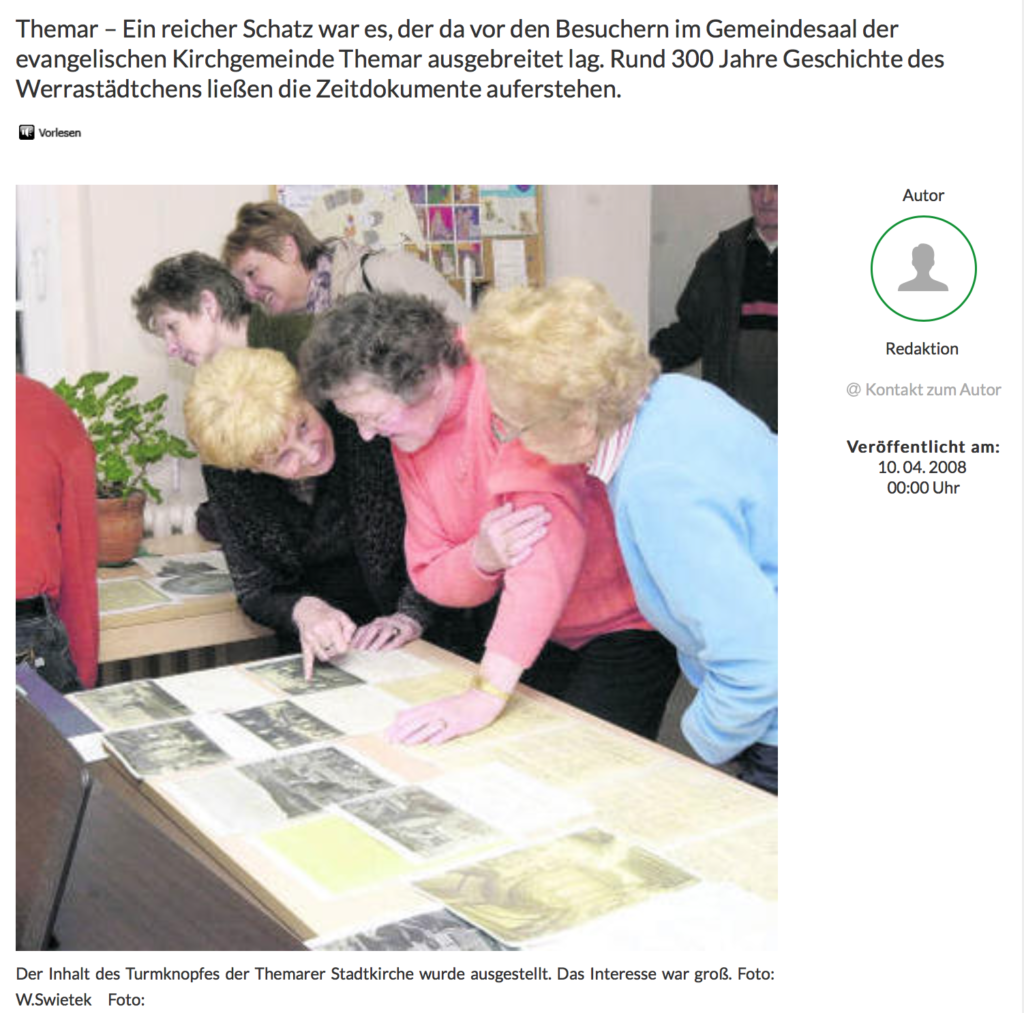Themar – “It was a rich treasure that lay spread out in front of the visitors in the community hall of the Protestant parish of Themar. Around 300 years of history of the Werra town brought the contemporary documents back to life.
Every time the tower crown needs a makeover, the documents contained in the tower knob come to light. And they are being scrutinized closely by the church community – just like last week in Themar.
But this often happens in a narrower circle, as was the case when it opened in 1950, when only the parish council was allowed to attend. Things were different in 2008: the public was invited. There was no free space in the community hall when Pastor Winfried Wolff invited people to view the contents of the metal capsules.
The oldest document that was kept in the tower button of the town church of St. Bartholomew dates from 1717. It is a commemorative coin with the image of the reformer Martin Luther, as well as a sermon text to commemorate the 200th anniversary of the Reformation.
The documents were laid out in chronological order in the community hall, with all the additions that were added to the individual openings of the tower button in 1923, 1950, 1964 and 1992. Retired pastor Arnd Morgenroth, whose father held the pastorate of the town church of St. Bartholomew for many years, took it upon himself to explain the documents.
What was touching was that he discovered his father’s documents in the tower button. He had realized his request that his son Arnd also study theology, but not his wish to also take over the pastor’s position in Themar. He was drawn to other regions of Thuringia. In the first few months of his retirement, Morgenroth was allowed to serve as pastor of the Themar parish for the first time.
“I still know him…”
He even discovered his own name on a list from October 12, 1950 with donors to the parish: “… Arnd Morgenroth, eight years, two marks”. And he continued reading: “Ursula Böttcher, eleven years, ten Pfennig-West”. The girl had brought the money with her from a trip to her relatives in the Ruhr area (which was still possible in 1950).
The closer Arnd Morgenroth came to the present – documents from the openings in 1950 and 1964 – the more moved the audience became. There were heckling calls when the name of a priest was mentioned: “I still know him, he confirmed me…”
Themar’s former mayor Klaus Rönnick, who was also in the audience, found his father’s documents – and other guests were also reminded of close friends from their youth, teachers, pastors and other people well known in the city. Anyone who made a contribution to the parish through donations or unpaid work had their achievements documented and preserved for posterity in the tower button.
The audience was just as interested in private matters as in contemporary historical documents. When Pastor Otto Störmer, during the installation of the first telephone connections in Themar in 1950, reported how “communication technology was developing in leaps and bounds. . .”, which is quite amusing in the age of cell phones and the Internet.
There is talk of cultural life in the Werra town in 1950, of the first fair after a twelve-year break, of the new school building, and of the performances by the choir and town band. And it should also be mentioned that almost every family in Themar now owns a radio.
deprivation and new beginnings
The handling of ration cards provides information about the deprivation of life in the post-war period. But also about the hopeful new beginning after the war years. The parish built the community hall in which this event took place in an annex to the rectory.
The first two of the three bells, which had been dismantled for war purposes and were actually supposed to be melted down, were returned in 1949. The church was now also used for Catholic services because the resettlers meant that more Catholics lived in Themar again. This apparently happened in good agreement, even without intensive efforts by the regional church to promote ecumenism.
We learn about the urgent “disaster repair” of the church tower, which had become a danger in the early 1960s, and the difficulty of finding not only the money, but above all the building materials, which were one of the greatest shortages at that time. If the Hildburghausen district building authority hadn’t had an insight at the last second. . .
The watchmaker Karl Saam is given words of praise. It was he who helped gild the weathercock. There is talk of a support group that was formed to support church repairs, which received more donations from pensioners and single women than from the “rich” citizens of Themar.
And again and again an ardent wish for peace is expressed by the pastors who added to the documents. This runs like a common thread through the documents in all three centuries.
Two well-traveled guests were particularly impressed by all of this: Rolf Lengemann from Mainz and Dr. Sharon Meen from the Holocaust Institute Vancouver in Canada, who currently want to research the history of the Jews in Themar – a less laudable chapter in the history of the city of Themar that has long needed to be addressed.
The parish still has time until June 7, 2008, when the tower crown of the town church of St. Bartholomew is to be put back on, to document events since it was last opened in 1992 and to supplement the tower button with meaningful documents from these 16 years. What will be added that will interest later generations as much as we do in the previous contemporary documents?”

